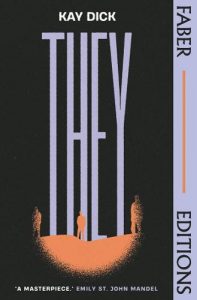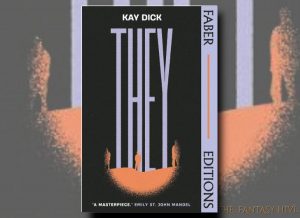THEY by Kay Dick (BOOK REVIEW)
Kay Dick – They (1977)
“’One must never forget,’ Russel said. ‘I hold it in my mind all the time. That way I’m continually on the lookout. It helps me move more quickly, knowing danger is there. It’s when you try and forget that trouble begins. That’s the way they approach, through the unguarded moment.’”
“’Love is unsocial, inadmissible, contagious.’ He grinned. ‘It admits communication. Grief for lost love is the worst offence, indictable. It suggests love has value, understanding, generosity, happiness.’”
Kay Dick was a pioneering queer writer and journalist who published five novels, a literary biography and a study on the commedia dell’arte. Then in 1977 she published They, a gloriously strange and disconcerting collection of linked stories set in an alternate dystopian Britain. They won the South-East Arts Literature Prize, but sold so poorly that her publisher refused to reprint it in paperback and it almost derailed her previously impressive career. They languished in obscurity for four decades, lost and forgotten. Fortunately for us, Faber Editions have rediscovered it and brought it back into print. Because They is an absolute masterpiece. In the now overcrowded field of dystopia, They still feels as fresh, innovative and subversive as it must have at the time it was released, and time has only made it look more impressive. Dick’s writing is beautiful, and the novel is imbued with a nocturnal, dream-like atmosphere of paranoia that recalls Franz Kafka and Anna Kavan, whilst its measured tone and fractured narrators brings to mind the work of Christopher Priest and Nina Allan. Gorgeous, haunting and harrowing, They is a neglected masterpiece whose time may have finally come.
 Unlike much dystopia, They does not focus on the corridors of power, the totalitarian mechanisms that create dystopia. Nor does it chronicle a rebellious uprising. Instead it focuses on what it’s like to live in a society that is becoming increasingly hostile to personal and artistic freedoms. The eponymous They are a spectral, menacing presence throughout the book. No one explicitly ever says who they are – it’s safer in general not to talk about them. But they have an increasing sphere of influence. They are regulating artistic and emotional expression, and they operate in the shadows and on the margins. You never know when they are going to break into your house and stealthily remove your books, or arrange for you to be taken away, incarcerated and brainwashed. Many of the characters in the book are artists, those whose studios have been destroyed, whose paintings and writing have been destroyed, who have been blinded or maimed in order to discourage them from creating their art. Resistance in They takes the form of fearlessly following one’s muse; creating one’s art in spite of the consequences one will face.
Unlike much dystopia, They does not focus on the corridors of power, the totalitarian mechanisms that create dystopia. Nor does it chronicle a rebellious uprising. Instead it focuses on what it’s like to live in a society that is becoming increasingly hostile to personal and artistic freedoms. The eponymous They are a spectral, menacing presence throughout the book. No one explicitly ever says who they are – it’s safer in general not to talk about them. But they have an increasing sphere of influence. They are regulating artistic and emotional expression, and they operate in the shadows and on the margins. You never know when they are going to break into your house and stealthily remove your books, or arrange for you to be taken away, incarcerated and brainwashed. Many of the characters in the book are artists, those whose studios have been destroyed, whose paintings and writing have been destroyed, who have been blinded or maimed in order to discourage them from creating their art. Resistance in They takes the form of fearlessly following one’s muse; creating one’s art in spite of the consequences one will face.
Much of They’s power comes from the way Dick creates tension and atmosphere. Like Anna Kavan, Dick is less focused on the mechanics of plot than creating an uneasy, surreal atmosphere that effectively conveys the feeling of the text. Dick’s style is similarly sparse yet starkly beautiful. Like Kavan’s Asylum Piece, They is told through a series of linked short stories. Fragmented and disorienting, the stories give us fragmented glimpses into the lives of people living in the alternate Britain in which they are in control. As the reader moves through the stories, which appear to be told out of sequential order, they get a better sense of what this world is like and how it got there. They seem to have started as a fringe group but have slowly manipulated their way into a position of power:
“I remembered how they began, a parody for the newspapers. No one wrote about them now. That was too dangerous. They were an ever-possible encounter. A potential menace one had to live with.”
The characters seek refuge in the countryside, away from their nexus of power in the cities, but as the timeline of the book progresses the circle of their influence widens until it swallows the whole country. They seems to have a particular link to youth and the young – children in particular cannot be trusted. And they use their power and influence to erase art and destroy culture, disapproving of artistic expression of any kind. Later on they extend their control to how emotion itself is culturally expressed, allowing restricted grieving periods for those who have suffered personal tragedies but condemning anything beyond the allotted two weeks as unhealthy and unpatriotic. And a large part of how they wield their power comes from the everyday people who become informants, the neighbour who turns you in, the citizens who reinforce the casting out of those deemed suspect.
All the stories are told by a nameless narrator, who often lives in the countryside and has a dog, and indeed some stories may be told by the same narrator, but given that many of them end with them winning and the narrator and their friends facing likely incarceration or worse, it seems unlikely they can all be the same person. Characters on the fringe of one story recur as the focus of another one. The end result is disorienting and frightening, as the reader is left unsure of the role played by each character and indeed who to trust. Many of the stories in They are explicitly about trust – characters suffer betrayals from friends, relatives and lovers, because they always have something they can hold over you. In ‘Pocket of Quietude’, Hurst betrays his friends and fellow artists because this is the price he pays for his own library of culture not being destroyed. In ‘The Visitants’, people who are single come under scrutiny, implying that the dystopian powers that be are sexually repressive. In ‘The Garden’, a garden of particular artistic beauty is preserved as a trap for artists. ‘Hallo Love’ shows how they regulate grief and grieving, with incarceration and brainwashing as punishment for having loved someone. The stories together create a powerful sense of unease, paranoia and distress, portraying a malleable world in which the suppression of truth, beauty and creativity ultimately leads to the suppression of human emotion.
They is such a powerful piece of writing precisely because of how it conveys what it feels like to live in a dystopia. Its dreamlike structure and fractured narrative wind up an incredibly effective way to convey the powerful emotions of paranoia and fear that run through the narrative. Dick’s dystopia stands easily with the genre’s best, and inhabits that vague, nebulous space in between genres where so much interesting writing takes place. It is a crying shame that it sold so poorly the first-time round and was lost to history, but I am beyond grateful to Faber for resurrecting it. Here’s hoping They finds the appreciation and respect it deserves.

